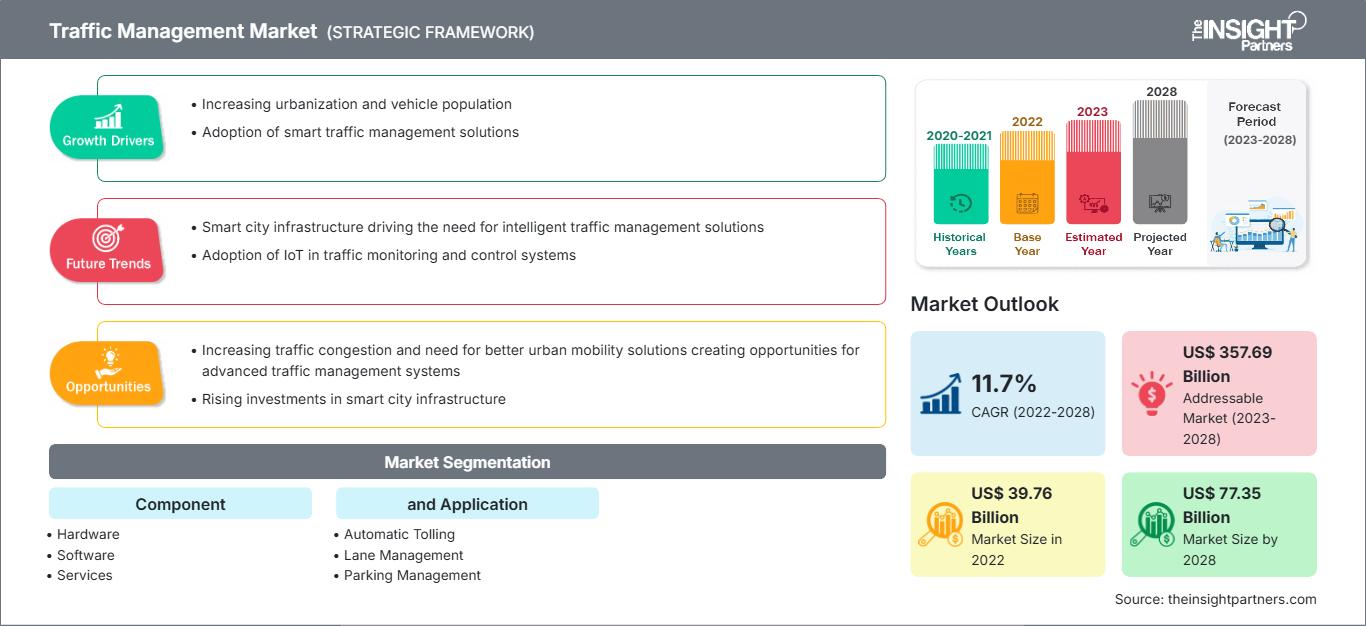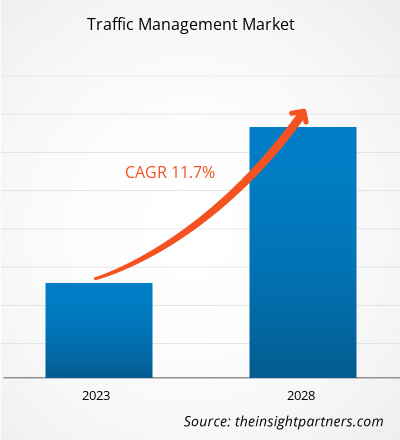Si prevede che il mercato della gestione del traffico raggiungerà i 77.346,44 milioni di dollari entro il 2028, rispetto ai 39.756,74 milioni di dollari del 2022; si prevede una crescita a un CAGR dell'11,7% dal 2022 al 2028.
Nel corso degli anni, la maggior parte dei paesi ha assistito a una drastica urbanizzazione, che ha portato a reti stradali complesse e a un'elevata congestione. L'aumento della popolazione urbana, unito all'aumento del numero di veicoli privati, ha aumentato il numero di veicoli in circolazione. La popolazione di Mumbai, in India, è passata da 18,5 milioni nel 2011 a 20,4 milioni nel 2020, mentre il numero di veicoli privati è quasi raddoppiato durante questo periodo. Grazie a tali fattori, e per porvi rimedio, si stima una crescita del mercato della gestione del traffico. Inoltre, i servizi di ride-hailing offerti da aggregatori di taxi, come Uber, Grab, Ola e Lyft, sono aumentati a un ritmo rapido. Tali servizi hanno sostituito i sistemi di trasporto pubblico, determinando un aumento del numero di veicoli in circolazione. Questi fattori stanno spingendo le autorità governative a rivolgersi agli operatori del mercato della gestione del traffico per trovare soluzioni efficaci. La congestione del traffico può essere efficacemente ridotta con un robusto sistema di gestione del traffico, composto da software, sensori, telecamere e pannelli informativi. Questi sistemi possono essere installati su una strada esistente senza la necessità di modifiche infrastrutturali. Allo stesso modo, un sistema di gestione delle corsie può gestire efficacemente il flusso del traffico aprendo o chiudendo le corsie, a seconda del traffico in ogni momento. Considerati i vantaggi offerti dai sistemi di gestione del traffico, si prevede che il rapido tasso di urbanizzazione aumenterà notevolmente le dimensioni del mercato della gestione del traffico.
Impatto della pandemia di COVID-19 sulla crescita del mercato della gestione del traffico
L'epidemia di COVID-19 ha sconvolto settori verticali come l'automotive, la produzione manifatturiera, l'energia e la potenza, l'aerospaziale e la logistica. Difesa, edilizia nel 2020. La continua crescita del numero di pazienti COVID ha costretto le autorità governative negli Stati Uniti e in altri paesi a imporre rigidi lockdown nei primi tre trimestri del 2020. Ciò ha portato a un calo significativo dei trasporti in tutti i paesi. L'implementazione di misure di contenimento come divieti commerciali, restrizioni di viaggio e limitazioni della forza lavoro ha avuto un impatto sulle attività di produzione, fornitura e vendita di varie aziende, comprese le aziende che forniscono hardware, software e servizi per la gestione del traffico. Il settore manifatturiero ha subito gravi perdite a causa di chiusure temporanee degli stabilimenti e bassi volumi di produzione, che hanno anche ostacolato la produzione di sistemi hardware per la gestione del traffico. Negli Stati Uniti, il governo federale e statale si è concentrato maggiormente sulla lotta alla pandemia; di conseguenza, l'installazione di hardware e software per la gestione del traffico è stata temporaneamente sospesa. Il settore europeo della gestione del traffico è stato gravemente colpito a causa di una riduzione di circa il 20% della spesa per progetti infrastrutturali, con conseguenti ritardi e interruzioni di diversi progetti di smart city e smart roadways. L'aumento dei prezzi dei semiconduttori e l'interruzione delle catene di approvvigionamento hanno ulteriormente aggravato la situazione. Tuttavia, il mercato della gestione del traffico ha iniziato a registrare una crescita positiva nel quarto trimestre del 2020.
Personalizza questo rapporto in base alle tue esigenze
Potrai personalizzare gratuitamente qualsiasi rapporto, comprese parti di questo rapporto, o analisi a livello di paese, pacchetto dati Excel, oltre a usufruire di grandi offerte e sconti per start-up e università
Mercato della gestione del traffico: Approfondimenti strategici

- Ottieni le principali tendenze chiave del mercato di questo rapporto.Questo campione GRATUITO includerà l'analisi dei dati, che vanno dalle tendenze di mercato alle stime e alle previsioni.
Potrai personalizzare gratuitamente qualsiasi rapporto, comprese parti di questo rapporto, o analisi a livello di paese, pacchetto dati Excel, oltre a usufruire di grandi offerte e sconti per start-up e università
Mercato della gestione del traffico: Approfondimenti strategici

- Ottieni le principali tendenze chiave del mercato di questo rapporto.Questo campione GRATUITO includerà l'analisi dei dati, che vanno dalle tendenze di mercato alle stime e alle previsioni.
Approfondimenti di mercato - Mercato della gestione del traffico
Il mondo sta assistendo a un boom dei dispositivi connessi e diversi paesi stanno investendo nello sviluppo di città intelligenti. Le città intelligenti sono aree urbane tecnologicamente avanzate che impiegano una varietà di sensori e metodi elettronici per raccogliere dati e utilizzarli per il miglioramento del territorio. Le città intelligenti sono progettate con piani a lungo termine per la gestione del traffico, ottimizzando i trasporti e la logistica e riducendo la congestione. Pertanto, oltre alle città intelligenti, i paesi stanno investendo anche nello sviluppo di strade intelligenti per garantire spostamenti più sicuri. Sulle strade intelligenti, diversi tipi di sensori e hardware raccolgono dati multivariati che vengono utilizzati per il monitoraggio del traffico. I dati possono anche essere condivisi con i veicoli in circolazione, consentendo a conducenti e pendolari di prendere decisioni informate. Pertanto, si prevede che la crescente adozione di città intelligenti e strade intelligenti aumenterà le dimensioni del mercato della gestione del traffico.
Approfondimenti basati sui componenti
Il mercato della gestione del traffico è segmentato in base a componenti, applicazione e area geografica. Il mercato, per componente, è segmentato in hardware, software e servizi. Il mercato dell'hardware è ulteriormente segmentato in telecamere, display e sensori; inoltre, il mercato del software è suddiviso in cloud e on-premise. Diverse agenzie governative hanno investito nell'aggiornamento del proprio hardware per la gestione del traffico. La crescente urbanizzazione e l'aumento del numero di automobili hanno gravato sulle strade urbane. Pertanto, le autorità si affidano a telecamere moderne per migliorare il controllo del flusso del traffico e garantire la sicurezza. Le telecamere per il riconoscimento automatico delle targhe (ANPR) vengono sempre più utilizzate per identificare i trasgressori o per localizzare i veicoli durante le indagini sugli incidenti. Sono spesso abbinate a sensori laser per determinare la velocità di un veicolo.
Per applicazione, il mercato della gestione del traffico è segmentato in pedaggio automatico, gestione delle corsie, gestione dei parcheggi, sorveglianza, gestione dei semafori e altri. In base all'area geografica, il mercato è principalmente segmentato in Nord America, Europa, Asia-Pacifico (APAC), Medio Oriente e Africa (MEA) e Sud America (SAM). IBM Corporation; Cisco Systems, Inc.; Siemens AG; Hangzhou Hikvision Digital Technology Co., Ltd. e Dahua Technology Co., Ltd. sono tra i principali attori del mercato della gestione del traffico.
Approfondimenti regionali sul mercato della gestione del traffico
Le tendenze regionali e i fattori che influenzano il mercato della gestione del traffico durante il periodo di previsione sono stati ampiamente spiegati dagli analisti di The Insight Partners. Questa sezione illustra anche i segmenti e la geografia del mercato della gestione del traffico in Nord America, Europa, Asia-Pacifico, Medio Oriente e Africa, America Meridionale e Centrale.
Ambito del rapporto di mercato sulla gestione del traffico
| Attributo del rapporto | Dettagli |
|---|---|
| Dimensioni del mercato in 2022 | US$ 39.76 Billion |
| Dimensioni del mercato per 2028 | US$ 77.35 Billion |
| CAGR globale (2022 - 2028) | 11.7% |
| Dati storici | 2020-2021 |
| Periodo di previsione | 2023-2028 |
| Segmenti coperti |
By Componente
|
| Regioni e paesi coperti | Nord America
|
| Leader di mercato e profili aziendali chiave |
|
Densità degli operatori del mercato della gestione del traffico: comprendere il suo impatto sulle dinamiche aziendali
Il mercato della gestione del traffico è in rapida crescita, trainato dalla crescente domanda degli utenti finali, dovuta a fattori quali l'evoluzione delle preferenze dei consumatori, i progressi tecnologici e una maggiore consapevolezza dei vantaggi del prodotto. Con l'aumento della domanda, le aziende stanno ampliando la propria offerta, innovando per soddisfare le esigenze dei consumatori e sfruttando le tendenze emergenti, alimentando ulteriormente la crescita del mercato.

- Ottieni il Mercato della gestione del traffico Panoramica dei principali attori chiave
Gli operatori del mercato della gestione del traffico si concentrano principalmente sullo sviluppo di prodotti avanzati ed efficienti.
- Nel 2021, Dahua Technology ha annunciato lo sviluppo di una soluzione completa per la gestione intelligente del traffico, sviluppata combinando videosorveglianza con intelligenza artificiale, ANPR, fusione di immagini, realtà aumentata e altre tecnologie all'avanguardia per soddisfare le diverse esigenze dei moderni dipartimenti di controllo del traffico.
- Nel 2021, Hikvision, fornitore di soluzioni IoT specializzato in telecamere, ha presentato la telecamera All-Rounder ITS, il suo ultimo prodotto per il traffico, pensato per migliorare la sicurezza stradale e il flusso del traffico. La telecamera combina una varietà di funzionalità e capacità, tra cui il rilevamento della velocità, il rilevamento delle violazioni del codice della strada, l'identificazione automatica delle targhe e l'analisi degli attributi del veicolo, il tutto in un unico pacchetto.
- Analisi storica (2 anni), anno base, previsione (7 anni) con CAGR
- Analisi PEST e SWOT
- Valore/volume delle dimensioni del mercato - Globale, Regionale, Nazionale
- Industria e panorama competitivo
- Set di dati Excel
Report recenti
Rapporti correlati
Testimonianze
Motivo dell'acquisto
- Processo decisionale informato
- Comprensione delle dinamiche di mercato
- Analisi competitiva
- Analisi dei clienti
- Previsioni di mercato
- Mitigazione del rischio
- Pianificazione strategica
- Giustificazione degli investimenti
- Identificazione dei mercati emergenti
- Miglioramento delle strategie di marketing
- Aumento dell'efficienza operativa
- Allineamento alle tendenze normative




















 Ottieni un campione gratuito per - Mercato della gestione del traffico
Ottieni un campione gratuito per - Mercato della gestione del traffico